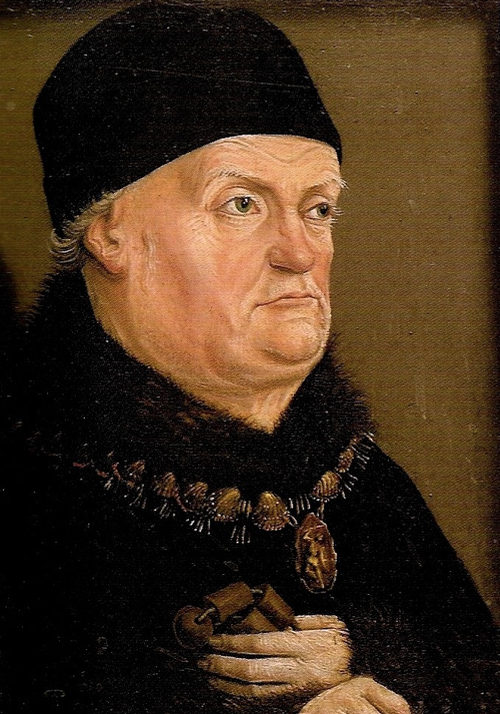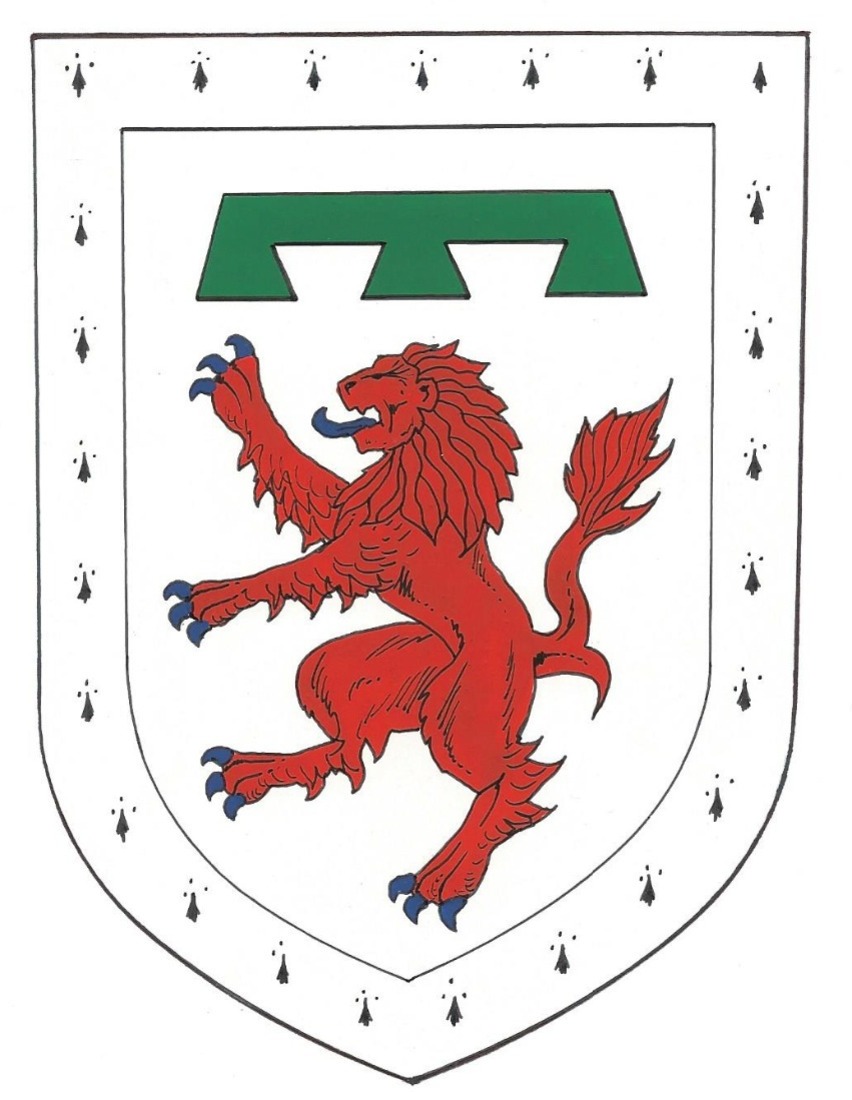Rene I King of Jerusalem and the 2 Sicilies
Head of The Order 1439-1480


Rene of Anjou, sometimes known as Rene the Good acquired quite an array of titles during his lifetime. He was Duke of Anjou, Count of Guise (1417) Count of Provence (1434-80), Count of Piedmont, Duke of Bar (1430-1480), Duke of Calabria, Duke of Lorraine (1431-1453), King of Naples (1435-1442, Titular King 1442-1480), King of Hungary, Titular King Of Jerusalem (1438-1480) and Aragon (1466-1480) including Sicily, Majorca and Corsica.
Rene was born at Angers in January 1409. His parents were Louis II Duke of Anjou and Provence and Yolande of Aragon. In 1419 his granduncle, the Cardinal Louis duke of Bar, adopted him as inheritor of the duchy of Bar. On his father’s death in 1417, René’s eldest brother, Louis III succeeded to Anjou, Maine and Provence.
In October 1420 aged eleven he married Isabelle, the nine-year-old heiress of Lorraine, her parents were Duke Charles II of Lorraine and Marguerite of Bavaria. At the time of René’s marriage, Charles, dauphin of France was married to René’s sister Marie and had lived at the Angevin court for five years.
By the time he was twenty, Rene and his wife were the parents of four children. Between 1420 and 1422 the Cardinal of Lorraine created l` Ordre de la Fidelite into which Rene was admitted as one of the original members.
Rene was at the court of Lorraine in Nancy in 1428 when Jeanne d` Arc visited to ask Duke Charles for assistance, she also asked for Rene to accompany her to the court of the dauphin at Chinon, which, for reasons unknown he declined to do. The following year however Rene fought alongside Jeanne at Orleans and after she had relieved the siege, she escorted the dauphin to Reims to be crowned King of France. Rene attended the coronation of Charles VII, his brother in law which took place in July 1429, following which Rene was knighted by the count of Clermont.
In August of that same year Rene again joined Charles VII and Jeanne d` Arc in their campaign against the English and on the 15th of that month led the army at the battle at Senlis; in September he was one of Jeanne’s s captains at the siege of Paris and it was Rene together with the Count of Clermont whom Charles sent to inform the Maid of Orleans that the siege of Paris was being withdrawn.
In June 1430 with the sudden death of his great-uncle, Cardinal Louis of Bar, Rene was made the new Duke of Bar and six months later on the death of Duke Charles II The Bold of Lorraine, he claimed that dukedom in his wife’s right, but was immediately involved in a family feud with another claimant, Antoine de Vaudemont. In that same year Rene launched an offensive into the neighbouring area of Champagne fighting against a Burgundinian army at which he won a major victory by seizing the town of Chappes a feat for which he was described by a chronicler as “a brave knight of great heart who showed himself to be proud and courageous.” In 1431 however he was defeated and captured at the battle of Bulgneville about ten miles south east of Neufchateau.by Antoine de Vaudemont whose army had been swollen with four thousand Burgundians.
Upon capture Rene was handed over to Antoine’s ally Philip the Good, Duke of Burgundy who incarcerated him at a château in Dijon. Rene eventually obtained his temporary release by exchanging himself for his two sons, agreeing to the betrothal of his eldest daughter the nine year old Yolande to Antoine`s heir the young Ferri de Vaudemont, a marriage which took place in 1445 twelve years later, as well as handing over part of the disputed lands of Lorraine as a dowry and a ransom
In 1434 the Holy Roman Emperor Sigismund recognised Rene as Duke of Lorraine and in the same year when Duke Louis III of Anjou, René’s eldest brother died while campaigning on behalf of Queen Joan II of Naples, Rene inherited Anjou and Provence from his brother. One year later he inherited the kingdoms of Naples and Sicily from Joan upon her death in February 1435.Taking umbrage with Rene’s further good fortune, the Duke of Burgundy had him returned to prison.
As Rene was held captive the Naples ambassadors crowned Isabelle on his behalf but when she set off for the city of Naples to take up her claim she was opposed by Alphonso V of Aragon who felt he had a greater claim to the throne Whilst still a prisoner Rene was still active politically and was used as a mediator for the Conference of Nevers between France and Burgundy and the agreement he brokered became the basis for the international Conference at Arras.
Finally released in 1437 after paying a further ransom of 400,000 ecus dor, the following year Rene set off for Naples which his wife had been defending against his rival, but after four years of fighting Rene was defeated and left Naples and Italy in June 1442 returning to France via Florence. At that stage he had many titles but little finance and so he and his brother Charles, Count of Maine became members of the Royal council. It was in 1439 that the Ordre du Lys, the original name of the Order of the Fleur de Lys was given its first Document a letter patent, by Rene.
In the 1420`s the Earls of Buchan, Douglas Murray and Mar had led some six hundred Scottish knights and men at arms to France to help the French King against the English. They were under the command of the Scottish Constable Sir John Stuart of Darnley and it was from the second contingent of Scottish mercenaries that the Order of the Fleur de Lys was eventually formed. In 1439 following the granting of its patent mentioned above Sir John Montgomery, who became the 2nd Laird of Giffen, the Seigneur d`Azay-le-Rideau and Constable of the Scots Army in France, with the banker Cosimo de Medici* funding the enterprise and under the patronage of Rene formed the Ordre du Lys. According to the historian Bo –Gabriel Montgomery, Sir John de Montgomery who was born in Ardrossan Scotland married Marie de Aussigny in 1448. They had three children two boys and a girl and the eldest son was named Rene Montgomery. Sir John died in 1485 on the battlefield at Haut –Rhin, in Alsace, France.
Peace between Rene and Philip of Burgundy finally came about when René’s eldest son Jean of Calabria married Marie of Bourbon, daughter of Charles1, duke of Bourbon and Philip’s niece in 1444. Also, in that year Rene and his brother in law King Charles VII saw further military action when they became involved in the siege of Vaudemont and the expedition against Metz.
From the 1420`s the English had been occupying Maine and Rene took part in the Anglo-French negotiations which began in 1444 in an attempt to recover it for his younger brother Charles. These discussions also led to the betrothal of his daughter Marguerite (Margaret) to King Henry VI of England in May 1444. The wedding was a two staged affair, the first part was her betrothal to the Duke of Surrey as surrogate for Henry, this taking place at Nancy were Rene not only took part in the ceremony but also planned the tournaments that took place during the festivities; the second stage being the actual marriage to Henry which took place in the less salubrious surroundings of Titchfield Abbey in Hampshire .As a result of this marriage Rene pressurised Margaret into persuading her husband to give up Maine and the English claims to Anjou which Henry agreed to, Maine was eventually won back by force of arms in1448; and it was during that year Rene founded The Military Order of the Crescent, composed mainly but not only of French Aristocrats (the Statutes of this Order being held in the Archives nationales Paris). This was a reputedly a revised version of the old Order of the Ship and Double Crescent, originally formed in 1269 by King Louis IX of France. The original knights of the Crescent included Francesco Sforza, Duke of Milan, and Ferri de Vaudmont his son in law.
Despite having King Henry VI of England as a son-in-law, Rene accompanied Charles VII on his victorious campaigns of 1449-50 against the English in Normandy. In February 1453 Isabelle of Lorraine died aged forty-three but eighteen months later the forty-five-year-old Rene married the twenty-one-year-old Jeanne de Laval, daughter of the Breton Guy XIV Count of Laval and Isabelle of Brittany. After his marriage Rene spent most of his time in Provence devoting himself to poetry, literature and the arts. In 1458 upon the death of Alphonse however Rene attempted to retake Naples and southern Italy, but after four further years of fighting returned to France having failed once again in the attempt.
In 1466 Rene was recognised by the Catalans of north eastern Spain as their king and his son Jean of Calabria set off for Spain to uphold the family rights. In December 1470, Jean of Calabria was killed in Barcelona, possibly poisoned, while on a campaign and so ended the Spanish pretensions. In René’s will he left Bar to his grandson René, Duke of Lorraine and Anjou and Provence to his nephew Charles Count of Le Maine. However, King Louis XI seized Anjou and Bar and the annexation of Provence
was only postponed until the death of the Count of Le Maine. Rene died at Aix-en Provence in July 1480 and was buried in the cathedral of Angers.
*Cosimo de Medici the elder and founder of the House of Medici, later Dukes of Florence and Grand Dukes of Tuscany was connected to both the Sforza`s and the d`Estes. In Florence the struggle for power between rival families was intense and Cosimo was expelled from the city in 1433 before returning and triumphing over his rivals in 1434. The basis of his wealth was the highly successful Medici bank. A keen patron of the arts he also undertook the building of the family palace, now known as Palazzo Medici Riccardi which was designed by Michelozzo. He was the employer of such artists as Donaletto and Uccello and his interest in ancient manuscripts and Byzantine esoterica was through the encouragement of Rene de Anjou who also fostered the transplantation of Italian Renaissance thought in his own dominions.

























